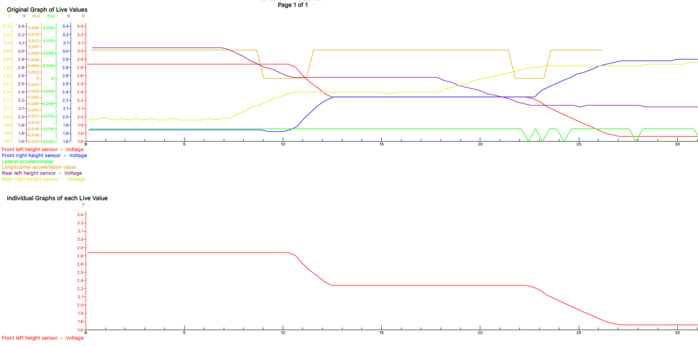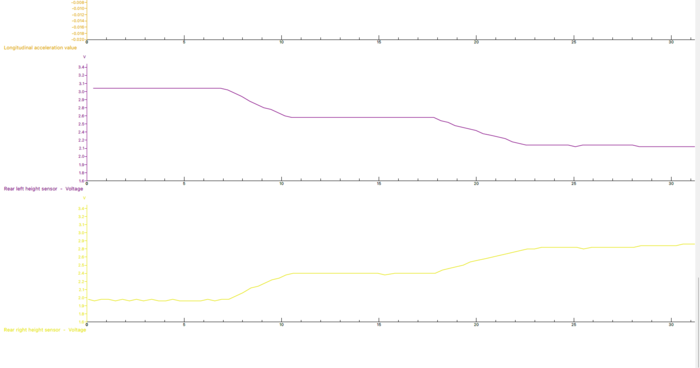 | Home > Technical (L322) > Help me out with the suspension on my 'famous' 4.4TDV8 L322! |
 
|
|
|
| GraemeS Member Since: 07 Mar 2015 Location: Wagga area Posts: 2762 
|
My IIDTool displays all CVD values. First view of the 4 height sensor voltages showed zeros for 3 sensors but then selecting 2 then 3 then all 4 again had all 4 voltages showing, so a bug in the initial display logic. Accelerometer voltages, damper duty cycles, current and lots of other values are viewable in either numeric or grahpic form. |
||
|
| colalowe Member Since: 11 Jul 2021 Location: Lancashire Posts: 107  
|
So armed with the information that the height sensors have a second output to the CVD I have adjusted the height of the car up by 5mm via the GAP tool, this now uses a different part of the sensor as its 'zero' point.
|
||
|
| GraemeS Member Since: 07 Mar 2015 Location: Wagga area Posts: 2762 
|
Why not graph the damper height settings as they're the ones used by the damper module? Check your accelerometer static values too and again driving slowly in a straight line over a slightly bumpy surface looking for excessive voltage changes from 1 or 2 sensors.
|
||
|
| MarianaWestminster Member Since: 14 Jun 2018 Location: UK Posts: 758 
|
Some fantastic work going on in here, looks like you guys are headed towards what may potentially be the issue with our vehicles.
|
||
|
| colalowe Member Since: 11 Jul 2021 Location: Lancashire Posts: 107  
|
I will have a go at recording the values, the height sensors don't have a physical contact patch but they can still fail, below are two videos on Youtube that show height sensor faults at certain points of the measured range. As far as I know the only way to test the CVD output of the sensor is to measure it with the Pico measurement system. I dont have that so its a bit of trial and error at the mo. 2012 TDV8 Autobiography Baltic Blue Previous 2007 BMW M5 E60 |
||
|
| GraemeS Member Since: 07 Mar 2015 Location: Wagga area Posts: 2762 
|
Your IIDtool can show the damper height sensor values just like the height sensor values. Adaptive dynamics is very close to the top of the list of ecus in the live values selection list. |
||
|
| GraemeS Member Since: 07 Mar 2015 Location: Wagga area Posts: 2762 
|
Silicon spray on the pivots and on the sensor shaft might free up the movement. |
||
|
| GraemeS Member Since: 07 Mar 2015 Location: Wagga area Posts: 2762 
|
This is incorrect. There are 6 wires going to each sensor, a set of 5V, earth and signal wires for each of the suspension and CVD sensors, with the shaft and housing the only parts in common. |
||
|
| colalowe Member Since: 11 Jul 2021 Location: Lancashire Posts: 107  
|
Hi GraemeS I cant see them on my GAP tool, I have the Quick list and complete list and I can only see the height values and not the active damper values from the sensor. From my last test today the graph showed my rear right sensor at the lower setting (near the original normal height setting) is not staying flat, I have also noticed that the Lateral sensor is not staying flat as well. The car was parked on a level flat surface and I tried with the engine running and engine off. I have ordered a full set of Height sensors and Im wondering if swapping the accelerometers around could show if the lateral sensor is faulty (i.e. the fault transfers to the location I swap it with)
 2012 TDV8 Autobiography Baltic Blue 2012 TDV8 Autobiography Baltic Blue
Previous 2007 BMW M5 E60 Last edited by colalowe on 27th Sep 2022 3:34pm. Edited 1 time in total |
||||
|
| Phoenix Member Since: 16 May 2022 Location: Gone Posts: 1631 
|
Moving the accelerometer to a different location will either confirm or deny a problem, the tolerance is 0.05VDC so if its within that, there is no point in moving it. When you say the height sensor voltage is varying, by how much? Presumably with the vehicle not moving with your comment of ign. On or off does the output to the EAS also vary?
|
||
|
| colalowe Member Since: 11 Jul 2021 Location: Lancashire Posts: 107  
|
The lateral sensor is bouncing between 0.016ms2 and 0.020ms2 not sure what that is in Volts.
|
||
|
| GraemeS Member Since: 07 Mar 2015 Location: Wagga area Posts: 2762 
|
Changing heights changes the track width so the tyres will be stretched inwards / outwards causing the height to not immediately at the required height, taking time to settle to the required height.
|
||
|
| Phoenix Member Since: 16 May 2022 Location: Gone Posts: 1631 
|
Those measurements are hardly 'bouncing' or erratic in the real world values, yes, there is some variation but hardly anything to cause concern. There is a basic error though, you're still only reading the EAS values and assuming the ADM is getting the same values - you really need to be looking at the data the ADM is receiving, forget the IID 'tool' use a voltmeter, the signals are analogue volts DC so easily readable. The height sensors are hall-effect sensors with a moving magnet, the output from the sensors are fed into a bit of electronics that created a linear DC voltage, it's likely that your fluctuations are due to that particular height sensor magnet moving between one hall sensor and another due to manufacturing variations (hence the banding in the graphs above) rather than an actual defect. similarly, the change in acceleration from 0.016 to 0.020m/s2 is miniscule and likely within the tolerance of the sensor, it appears that the front sensor value is a composite value of both sensors so subject to some sort of averaging / weighting - and more likely to appear 'stable'. Personally, i think you're seeing big changes because the graph is magnifying the readings, if you were to graph across the range of acceptable signal, you wouldn't notice the slight variation you're seeing. I think you're playing parts roulette in changing the height sensors without any solid measurements or evidence to show a defect - you'll also need to calibrate the new sensors due to manufacturing variations. But it's your money... |
||
|
| GraemeS Member Since: 07 Mar 2015 Location: Wagga area Posts: 2762 
|
The IIDtool is easy to use and it doesn't compromise the waterproof connector seals which occurs when poking a probe into the connector.
|
||
|
 
|
|
| All times are GMT + 1 Hour |
< Previous Topic | Next Topic > |
Posting Rules
|
Site Copyright © 2006-2025 Futuranet Ltd & Martin Lewis
![]()

